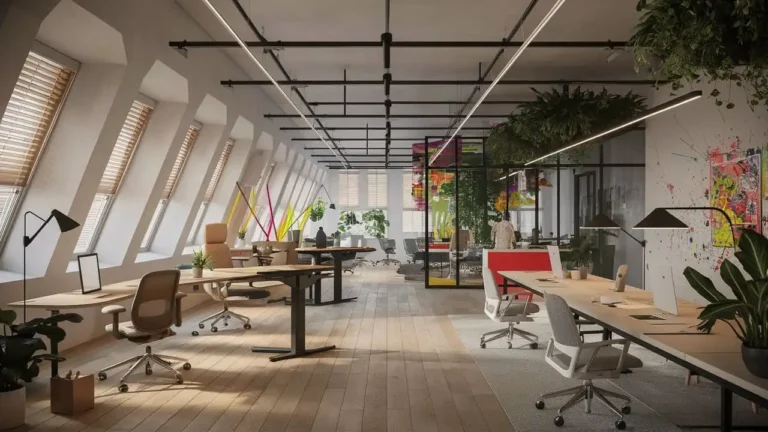Imagine walking into an office every day that not only reflects your brand’s identity but also sparks creativity, elevates productivity, and comforts your spirit. You deserve a space that works as hard as you do—a place where every design element, every line and modern accent, and every piece of office furniture contributes to an environment that truly inspires. In this comprehensive guide, you’ll discover how to transform your office interiors with the best office interior design ideas, whether you’re revamping a corporate office interior design, a small office, or even your home office. Let’s dive into a step-by-step process that will help you create a functional, modern office design that fits your business needs and expresses your creativity.
Table of Contents
1. Understanding Office Interior Design
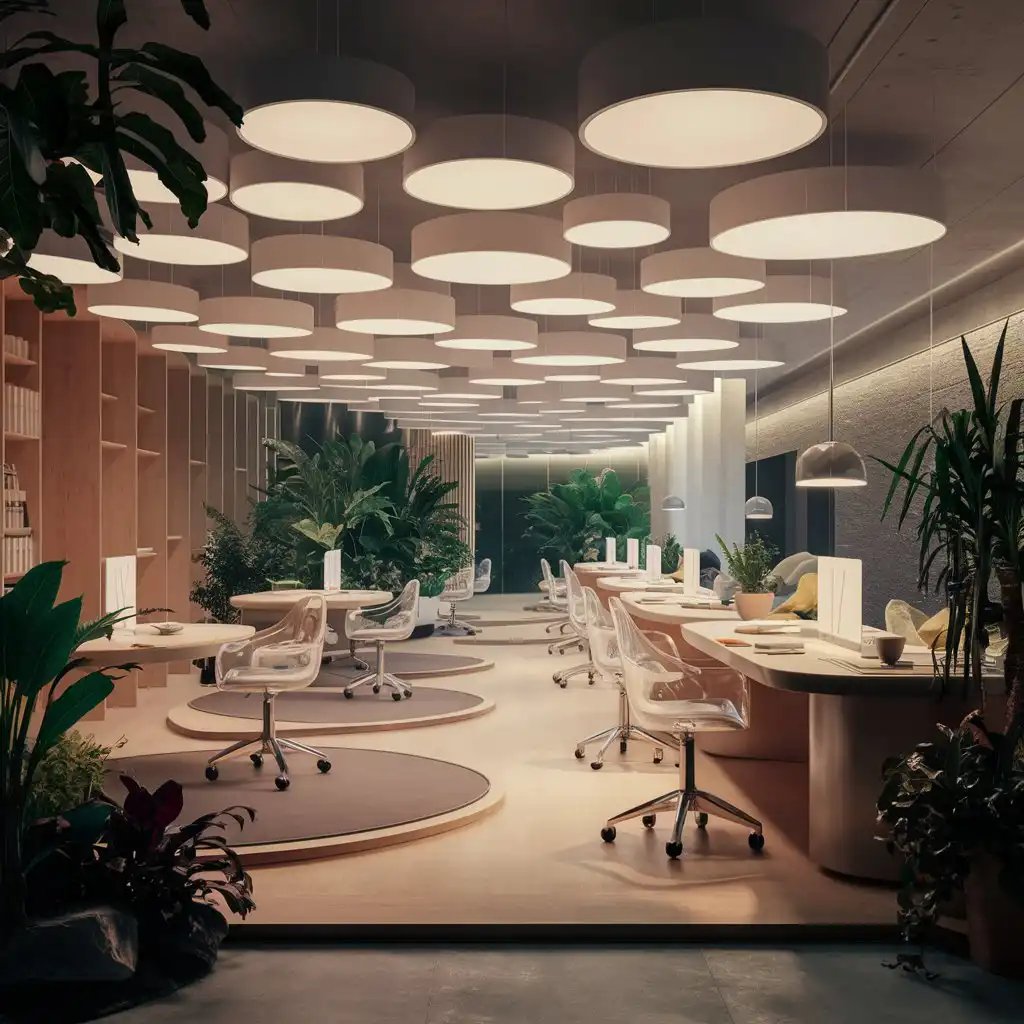
Before you begin, it’s essential to understand the core of office interior design. This isn’t just about picking a trendy color or following the latest decorating ideas—it’s about crafting an environment that enhances employee productivity, supports natural elements, and ultimately, mirrors your brand’s ethos.
1.1 What Is Office Interior Design?
Office interior design is the art and science of planning, designing, and decorating office spaces to ensure they are both aesthetically pleasing and functionally efficient. It encompasses everything from the office layout and workspace design to the incorporation of natural light, biophilic design, and even the selection of the best office interior designer for your project.
- Key Aspects Include:
- Office Layout: A well-thought-out floor plan that considers common areas, workstations, and meeting rooms.
- Design Elements: From modern office interior design features like clean lines and pops of color to more organic touches such as natural elements and biophilic design.
- Office Furniture: Ergonomic desks and chairs that support employee productivity.
- Technology Integration: Smart systems to improve connectivity and streamline work processes.
1.2 Why Office Interior Design Matters
You might wonder why investing in a quality design studio or finding an interior designer is so crucial. The truth is, a well-designed workspace can significantly influence the overall office environment, employee productivity, and even the company’s image.
Benefits Include:
- Enhanced Productivity:
A layout that is carefully drawn to scale and matches visual weight can improve workflow, allowing employees to work efficiently. - Employee Well-Being:
When you incorporate elements like natural light, a sense of calm through strategic use of color, and ergonomic office furniture, your team is more likely to experience reduced stress and increased job satisfaction. - Brand Identity:
Your office design crafted with elements that reflect your brand can create a lasting impression on clients and partners. - Cost-Effectiveness:
Even though redesigning an office space might seem time-consuming and complex, strategic upgrades can ultimately save you money by improving energy efficiency and reducing clutter.
2. Key Elements of Inspiring Office Interior Design
Designing your office is not just about aesthetics—it’s about functionality and creating an environment that fosters success. Below are the critical elements you should consider when planning your office interiors.
2.1 Space Planning & Layout
The foundation of a great office design starts with an efficient layout. Whether you’re working with an open plan or partitioned spaces, every inch matters.
- Consider These Elements:
- Zones for Collaboration vs. Quiet Work: Create designated areas for teamwork as well as private spaces where individuals can focus.
- Flexibility: Plan for multipurpose areas that can serve as common areas or meeting rooms as needed.
- Office Layout Ideas: Utilize floor plans that incorporate an open floor for a modern office interior design and strategic placement of workstations and common areas.
2.2 Lighting, Colors & Acoustics
Lighting, colors, and acoustics play a pivotal role in setting the tone of your office environment. They not only affect aesthetics but also influence mood and productivity.
Consider This Table for Best Practices:
| Element | Impact on Productivity | Best Practices |
|---|---|---|
| Lighting | Enhances mood, reduces eye strain, and energizes you | Maximize natural light, supplement with LED options, and use dimmable fixtures for flexibility. |
| Colors | Influences focus and creativity | Incorporate brand colors, use blues and greens for calmness, and add pops of color for energy. |
| Acoustics | Minimizes distractions in open space areas | Use acoustic panels, carpets, and soft furnishings to absorb sound effectively. |
By following the above strategies, you can create an office design that not only looks modern but also supports employee productivity.
2.3 Ergonomic Furniture & Tech Integration
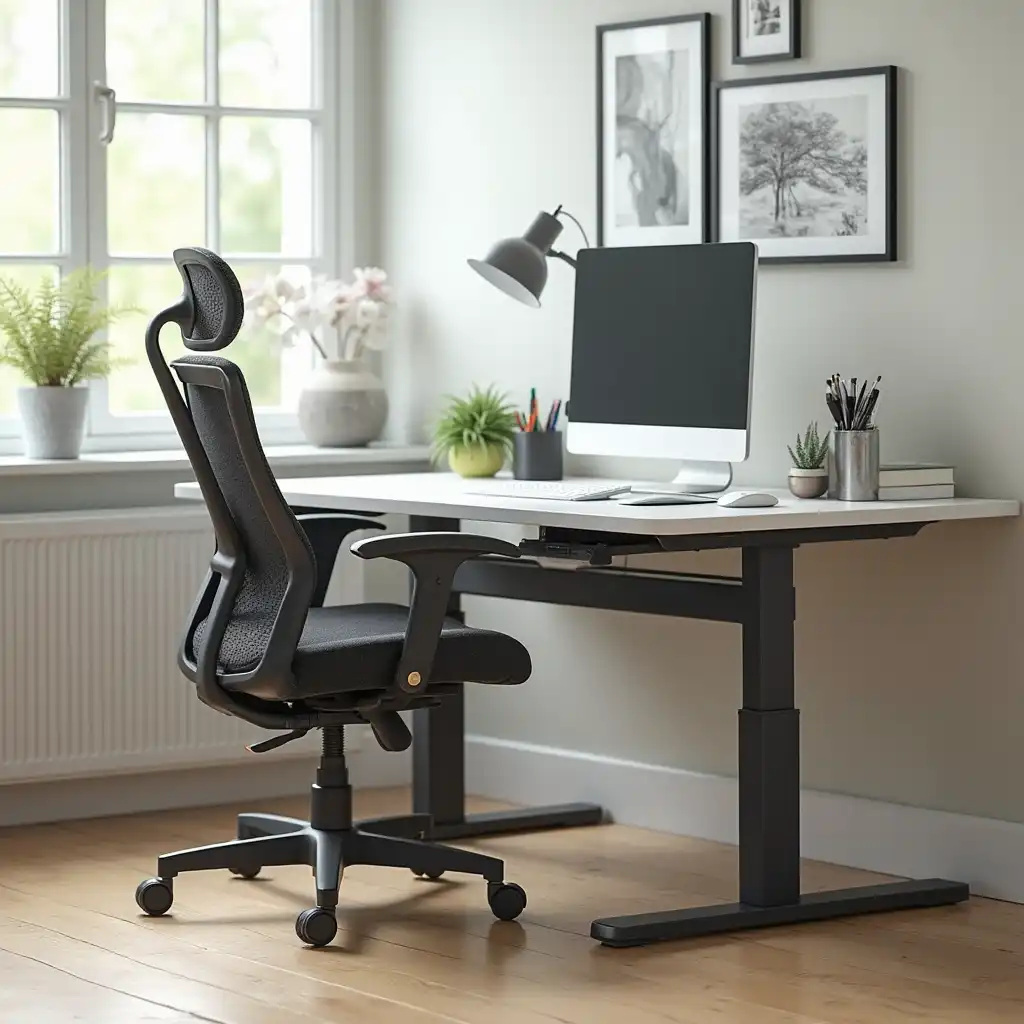
When it comes to office interiors, the furniture you choose and the technology you integrate can make a massive difference. Ergonomic office furniture is essential in preventing fatigue and promoting good posture.
- Focus on:
- Ergonomic Chairs and Desks: Choose pieces that provide comfort and support.
- Tech Elements: Integrate connectivity elements like wireless charging stations and smart boards that can be easily added to your office layout.
- Design Studio Insights: Look for design features that balance form and function—after all, interior designers work hard to create spaces that are both stylish and practical.
3. Boosting Productivity Through Office Interior Design
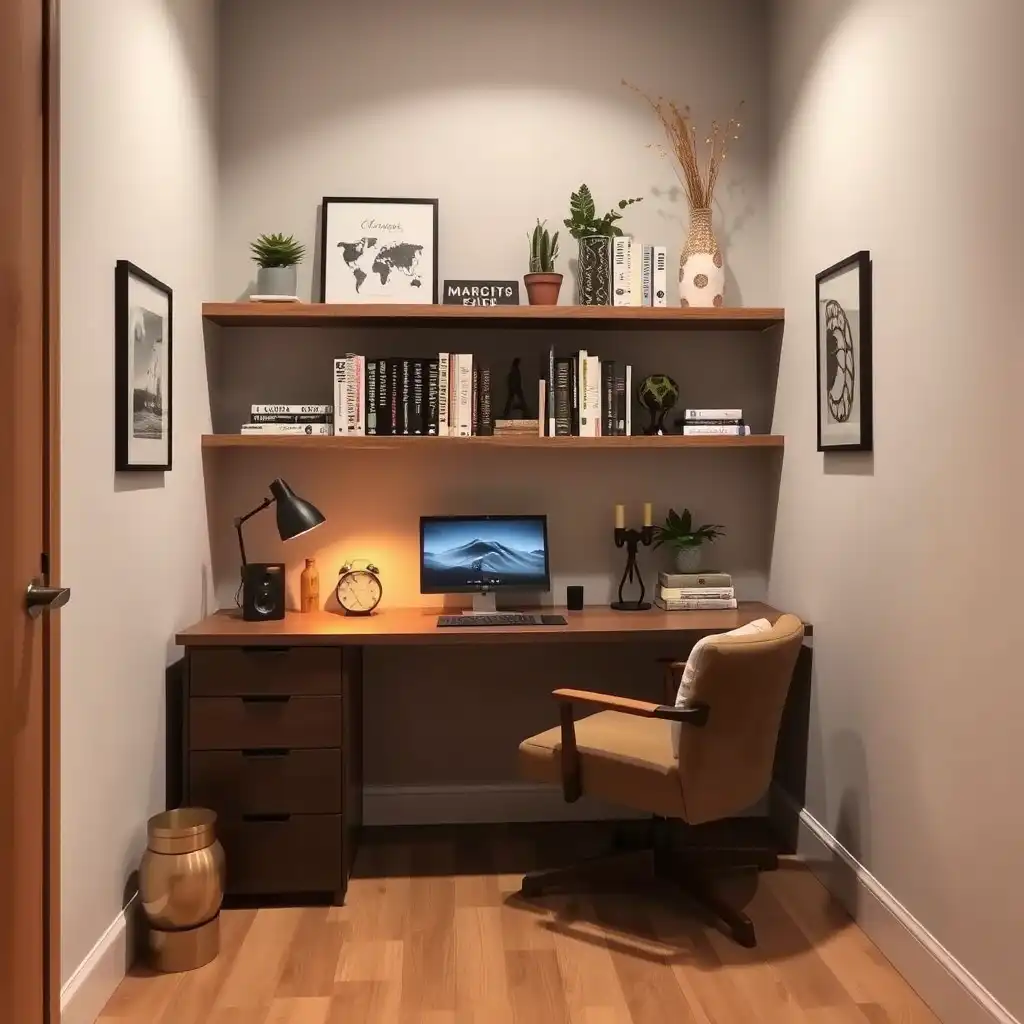
A beautifully designed office is more than just eye candy—it directly impacts how well you and your team perform. Let’s explore some effective strategies to boost productivity through thoughtful office interior design.
3.1 Design Strategies to Enhance Productivity
Here are a few actionable strategies that you can implement in your workspace:
- Optimize Your Layout:
Create an open plan that encourages collaboration while providing designated quiet zones for deep work. - Invest in Ergonomics:
Choose a desk and chair that support long hours of productivity and reduce the risk of strain. - Incorporate Natural Elements:
Utilize biophilic design by adding plants and natural materials to create a sense of calm. - Improve Lighting:
Ensure that your office has ample natural light and supplement with modern LED solutions. - Reduce Clutter:
Keep your workspace organized by avoiding excessive clutter, and use storage solutions that are both stylish and functional.
Supporting Data:
Studies have shown that offices designed with a focus on ergonomics and natural light can boost employee productivity by up to 20%. Consider exploring related blog posts and case studies for a more in-depth analysis.
3.2 Creating a Productive Atmosphere
A productive office environment is not only about the physical space—it’s also about the atmosphere you cultivate.
- Tips to Enhance Atmosphere:
- Use a Focal Point:
Create one focal point in the office where design elements converge—a well-chosen piece of art or a signature piece of modern office interior design can serve as a daily reminder of your company’s vision. - Maintain a Sense of Calm:
Incorporate a soft color palette and comfortable furniture to create an environment that feels inviting and reduces stress. - Encourage Movement:
Design common areas and break zones that allow employees to step away from their desks, ensuring they remain energized throughout the day.
- Use a Focal Point:
By carefully curating your office design, you can set the stage for an environment that not only meets business needs but also promotes a high level of employee productivity.
4. Styling Your Office: Balancing Productivity & Aesthetics
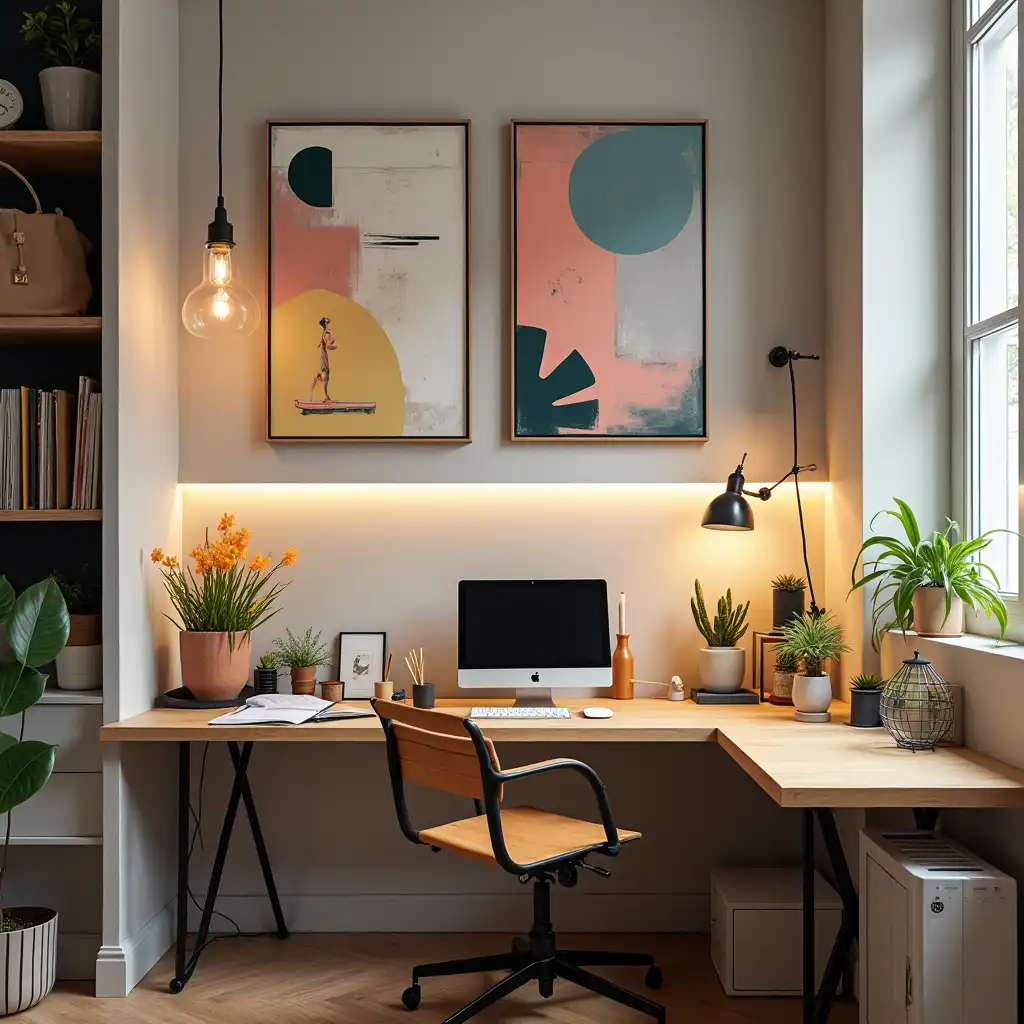
Achieving the right balance between productivity and aesthetics is the key to an office environment that truly inspires. Whether you’re looking for modern office interior design ideas or classic decorating ideas, the following tips will help you strike the perfect balance.
4.1 Incorporating Brand Identity
Your office is a reflection of your business. Incorporate your brand identity into your design to create a cohesive look that resonates with both employees and clients.
- Ways to Incorporate Brand Identity:
- Customized Wall Art:
Use office interior design ideas that include personalized artwork, which aligns with your company’s ethos. - Color Palette:
Select colors that match your brand’s guidelines—this not only creates consistency but also reinforces brand recognition. - Unique Decor Elements:
Choose decor pieces that embody the spirit of your business. Whether it’s modern office design with sleek lines or traditional interior decorating, the goal is to create a space that is unmistakably yours.
- Customized Wall Art:
4.2 Art, Decor & Personal Touches
Art and decor are essential components of any inspiring workspace. They add personality and can make a lasting impression.
- Key Considerations:
- DIY vs. Professional:
Decide whether you want to explore DIY office interior design ideas or hire an office interior designer. Sometimes, a professional touch can elevate your space significantly. - Pops of Color:
Use accents and decor that add vibrancy—these little details, such as a well-placed collection of objects or a single focal point, can transform your office. - Express Your Creativity:
Allow room for personal touches, whether it’s through design elements that reflect global design trends or simple decorating ideas that make your office feel warm and welcoming.
- DIY vs. Professional:
5. Practical Tips & Budget-Friendly Ideas
Transforming your office doesn’t have to break the bank. With a few clever strategies, you can create a stunning environment that meets your business needs while staying within budget.
5.1 DIY Office Interior Design Ideas
If you’re not keen on hiring a professional right away, consider these DIY strategies:
- Step-by-Step Process:
- Declutter First:
Begin by clearing out unnecessary items—this creates a blank canvas for your design. - Repurpose Existing Furniture:
Sometimes, a simple rearrangement of your current office furniture can breathe new life into the space. - Add Connectivity Elements:
Use platforms and apps that allow you to simply add walls or design elements virtually, then modify as needed. - Incorporate Natural Elements:
Add indoor plants, natural light fixtures, and textures that evoke nature. These home office design ideas can be just as effective in a corporate space.
- Declutter First:
- Quick Tips:
- Use a design studio tool or a planner 5d user app for 3D visualization.
- Follow an easy step-by-step process to create a focal point and ensure matching visual weight throughout the space.
5.2 Affordable Upgrades & Cost-Saving Measures
Even if you’re working with a limited budget, there are plenty of cost-effective strategies to upgrade your workspace.
- Budget-Friendly Ideas:
- Opt for Upcycled Furniture:
Instead of investing in brand-new items, consider repurposing and updating existing office furniture. - DIY Decorating:
Explore decorating ideas that involve minimal expense—think DIY wall art, simple desk accessories, and creative storage solutions. - Focus on High-Impact Areas:
Prioritize improvements in common areas and workstations where changes can have the biggest determining factors on productivity. - Look for Deals:
Search for inspiration on related blog posts and check out platforms where interior designers work to offer affordable options.
- Opt for Upcycled Furniture:
6. Case Studies and Data-Driven Insights
Learning from real-life examples can provide you with invaluable insights into how a well-planned office interior design can transform a workspace. Below, we highlight a couple of successful projects and data trends that showcase the impact of thoughtful design.
6.1 Successful Office Interior Design Projects
Consider these examples that illustrate the power of modern office design:
| Project Name | Design Style | Key Changes | Measured Outcome |
|---|---|---|---|
| Modern Collaborative Office | Contemporary/Industrial | Open floor plan, ergonomic workstations, natural light | +20% boost in employee productivity, +15% satisfaction |
| Eco-Friendly Startup Space | Biophilic/Sustainable | Integration of green spaces, recycled materials | +25% reduction in energy costs, enhanced well-being |
Key Insights:
- Modern Office Interior Design:
The first project emphasizes the importance of an open plan that fosters collaboration. By drawing to scale and ensuring a balance between functionality and style, this design helps create an inviting office environment that meets both business needs and design aspirations. - Biophilic Design Trends:
The eco-friendly startup showcases how natural elements and sustainable design can not only enhance aesthetics but also contribute to significant cost savings and a healthier office space.
6.2 Data and Trends
Keeping up with trends in office interior design is vital to ensure your workspace remains contemporary and competitive. Here are some trends and data-backed insights for 2025:
- Increased Focus on Natural Light:
Modern office interior design now prioritizes natural light. Offices that incorporate large windows and open floor layouts see higher productivity rates. - Ergonomic Innovations:
The integration of ergonomic office furniture has shown a measurable improvement in employee comfort and productivity. - Tech-Integrated Workspaces:
Incorporating smart office features like wireless charging and connectivity elements is becoming a standard requirement in contemporary office design. - Biophilic Design:
Offices that bring in natural elements, such as indoor plants and organic textures, benefit from reduced stress levels and an overall sense of calm.
For more detailed insights, explore related blog posts and case studies from reputable architecture and design firms that specialize in creating functional office interiors.
7. Frequently Asked Questions (FAQ) About Office Interior Design
Here are some of the top questions you might be asking about office interior design, answered to help you make informed decisions:
Q1: What is Office Interior Design and why is it important?
A: Office interior design goes beyond aesthetics—it’s about creating an environment that enhances productivity, supports employee well-being, and reflects your brand identity. Whether it’s a small office or a large corporate space, the right design elements can make a significant difference.
Q2: How does Office Interior Design boost productivity?
A: By optimizing the office layout, incorporating ergonomic furniture, maximizing natural light, and integrating modern design features, you create a space where employees can work more efficiently. This results in improved focus and a tangible boost in employee productivity.
Q3: What are some budget-friendly Office Interior Design ideas?
A: Consider DIY projects like repurposing existing furniture, adding connectivity elements through user-friendly design apps, and using affordable decorating ideas. Look for platforms that offer cost-effective design options and inspiration from interior designers work and global design trends.
Q4: How can I integrate technology into my office design?
A: Modern office interior design now includes smart connectivity elements such as wireless charging stations, digital boards, and efficient cable management. These features ensure that technology is seamlessly incorporated into your office environment.
Q5: What are the latest trends in Office Interior Design for 2025?
A: Expect to see a greater focus on biophilic design, sustainable materials, ergonomic workstations, and open-plan layouts that encourage collaboration while maintaining distinct zones for focused work. The trends emphasize both employee productivity and a sense of calm through natural elements and well-designed office features.
8. Conclusion
Final Thoughts
You now have a comprehensive guide that covers everything from the basics of office interior design to actionable strategies that boost productivity and style. By understanding key elements like space planning, lighting, ergonomic furniture, and technology integration, you can transform your workspace into a place that truly inspires creativity and meets your business needs.
Remember, the journey to a well-designed office is a step-by-step process—start from scratch if you must, or simply make changes to existing elements. Whether you’re a planner 5d user or you prefer to work with an experienced office interior designer, what matters is that you express your creativity and design a space that reflects your unique taste and professional aspirations.
Call-to-Action
Ready to transform your workspace? Take the insights from this guide and start planning your modern office interior design today. Explore our collection of office design ideas, get inspired by related blog posts, and if you need further assistance, find an interior designer who can help you convey your vision. Don’t wait—make your office a place where productivity meets style. Share your before-and-after stories, and let us know how your office helps boost employee productivity and create a sense of calm in your daily work environment.

